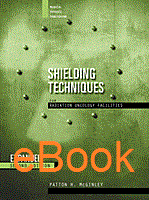
Shielding Techniques for Radiation Oncology Facilities, Second Edition
Author: Patton H. McGinleyISBN: 9781930524675
Published: 2002 | 184 pp | eBook
OUT OF PRINT
Medical Physics (Review of the First Edition) | August 1998
Review of the First Edition:
"The first place a medical physicist looks for help to calculate the necessary shielding for a new radiation therapy facility is in the NCRP reports. Report #s 49 (1976) and 51 (1977) deal with x-rays and gamma rays up to 10 and 100 MeV, respectively, while report #79 (1984) deals exclusively with neutrons. For a facility with a 6 MV linear accelerator, all the necessary shielding information is to be readily found in Report #49. For a dual energy linear accelerator with a maximum energy of 15 or 18 MV, additional information can be found in report #51; the problem of neutrons at x-ray energies MV can be handled using report #79. It cannot have escaped the average physicist's notice that the information in these reports is comprehensive only for low energy x-rays and, even then, there are some deficiencies. For example, the reports equate head leakage TVLs with primary beam TVLs, there are no scatter factors for high energy x-rays and practical methods for calculating door shielding thicknesses of lead with or without borated polyethylene (BPE) are not provided. Since those NCRP reports first came out, the field of radiation therapy has undergone a rapid transfomation from low to high energy therapy machines, so these problems have now become more pressing. However, there has been substantial reasearch in this area over the past few years, the results of which need to be included in the old reports. It is for this reason that Report #49 is currently under revision by an AAPM task group and an NCRP committee to include all new information for x-rays and neutrons. "This book on shielding techniques by Patton McGinley not only fills the gaps left by the outdated NCRP reports, but, more importantly, provides practical methods for solving all of the typical problems encountered by the shielding designer. It covers areas from low to high energy x-ray beams, from rooms with mazes to those without and from simple concrete barriers to complex arrangements involving lead or steel in addition to concrete. It also includes information on skyshine, design of HDR and brachytherapy rooms, ozone production, air activation, and advice on writing reports for regulatory authorities. The chapters are well organized, so that one can readily turn to a particular topic for reference, as is the usual wont when designing a room. The book is considerably helped by the aid of example calculations at the end of each section; this will certainly clarify any misunderstandings about the calculational methodology. This is a comprehensive, well-written, easy-to-read book that I belive is as necessary to a sheilding designer as the NCRP reports, since it translates those reports into practical terms and includes much updated information. "There are a few minor points that do not mar this volume but could well be corrected or incorporated in the next edition. The introduction on the 'history of room shielding' is curious for its omission of any discussion of 60Co units; this is probably because the section was taken from one written by the author for Health Physics to celebrate the Roentgen centenary. In the same section, the betatron's mode of operation is not clearly explained. Room designers, who are used to dealing with workloads in terms of cGy per week and maximum permisssible does of mSv per week, would find it a great inconvenience to discover all the tables with dose equivalents outside the room in terms of 'nSv s-1.' These are units that the typical designer would never use and they would most likely do as I did, namely pencil in each table the equivalent values using conventional units. The only omission for shielding consideration is an x-ray or electron-only facility that uses lead with or without BPE instead of concrete. Solutions to calculational problems left for the reader should have been provided. "This is the first self-help book on this topic on the market and is therefore a welcome addition. It should certainly be considered a must-buy for all shielding designers. Finally, the publishers should be congratulated on producing a book with an attractive cover; addition of the art work is a welcome change from the standard plain jacket."
Peter J. Biggs Peter J. Biggs, Ph.D., is Associate Professor and Acting Head, Division of Radiation Biophysics, at the Massachusetts General Hospital in Boston, Massachusetts.

